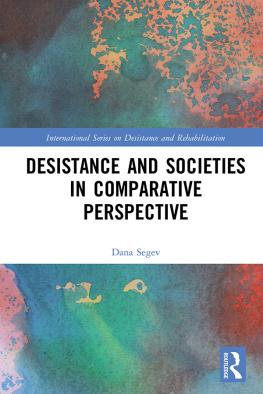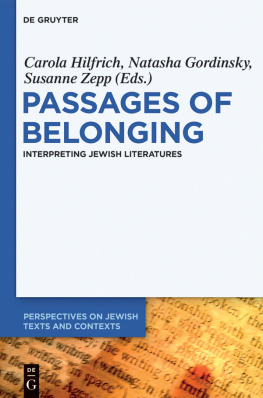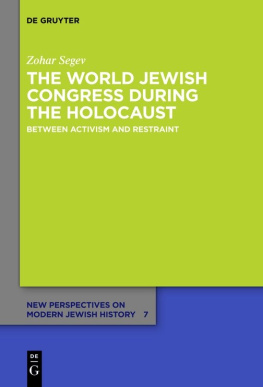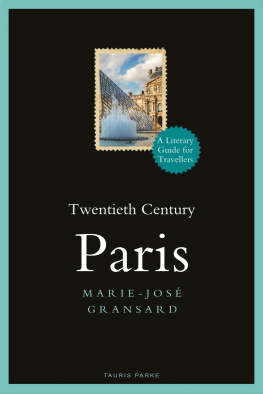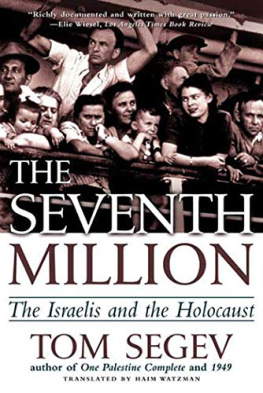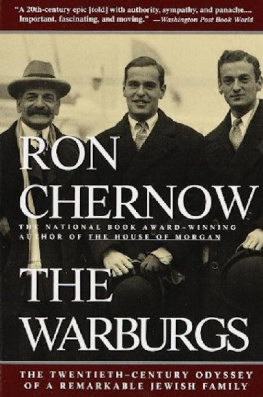Stanford University Press
Stanford, California
2018 by Sarah E. Wobick-Segev. All rights reserved.
No part of this book may be reproduced or transmitted in any form or by any means, electronic or mechanical, including photocopying and recording, or in any information storage or retrieval system without the prior written permission of Stanford University Press.
Printed in the United States of America on acid-free, archival-quality paper
Library of Congress Cataloging-in-Publication Data
Names: Wobick-Segev, Sarah, author.
Title: Homes away from home : Jewish belonging in twentieth-century Berlin, Paris, and St. Petersburg / Sarah Wobick-Segev.
Description: Stanford, California : Stanford University Press, 2018. | Series: Stanford studies in Jewish history and culture | Includes bibliographical references and index.
Identifiers: LCCN 2017052515 (print) | LCCN 2017053531 (ebook) | ISBN 9781503605145 (cloth :alk. paper) | ISBN 9781503606548 (ebook)
Subjects: LCSH: JewsEuropeSocial life and customs20th century. | Judaism and secularismEuropeHistory20th century. | Community lifeEuropeHistory20th century. | Public spacesEuropeHistory20th century. | IndividualismEuropeHistory20th century. | LeisureEuropeHistory20th century.
Classification: LCC DS135.E83 (ebook) | LCC DS135.E83 W63 2018 (print) | DDC 305.892/404dc23
LC record available at https://lccn.loc.gov/2017052515
Cover design: Angela Moody
Cover painting: Lesser Ury, Lady in black evening dress with green scarf (1908).
Wikimedia Commons
Typeset by Bruce Lundquist in 11/14 Adobe Garamond Pro
Acknowledgments
Historical writing is a lonely task, or so we are frequently reminded. Yet, from the very first days of graduate school to the last stages of putting together this monograph, I have been surrounded by dedicated, supportive, and generous people. I am so very pleased now to be able to thank them here.
This book had its origins in a series of seminars at the University of WisconsinMadison, which turned my attention to consumerism, space, religion, and comparative European history. During this time, I had the good fortune to learn from and work with Rudy Koshar, David McDonald, and Mary Louise Roberts. Their careful reading, feedback, and guidance helped me not only to begin this project but also to turn it into a book. I owe a great debt of gratitude to Tony Michels. I thank him for his time and mentorship and for the many engaging conversations, which helped me formulate some of the essential arguments of this book. It is impossible to imagine this book having come into fruition without the support and advice of my adviser, David Sorkin. David has guided me through many stages of this project and my early career. I have benefited profoundly from his intellect and erudition, and no less from his faith in my work and in this book. I am deeply grateful for his continued help and support.
During graduate school, I had the immense fortune to meet a series of engaged and driven young scholars, including a number who came from Israel every year as part of the George L. Mosse exchange program. I am so very thankful to Sean Gillen and Stacy Milacek for helping me survive graduate school and to Naama Cohen-Hanegbi, Arie Dubnov, Gil Ribak, Adi Gordon and Vanessa Walker, and Scott Ury for their support, friendship, and guidance. As well, Ethan Katz has unhesitatingly and repeatedly offered sound advice and kindly read through parts of the manuscript. Gideon Reuveni has been a friend, collaborator, and early champion of my work. I am grateful for his support and the time he spent reading parts of this monograph. And Ofer and Jen Ashkenazi have long earned my deepest and most profound gratitude; colleagues and dear friends, they have been nothing less than lifelines in interesting times.
Since leaving Madison, I have had the pleasure of working with and getting to know a number of other scholars who have taken the time to read parts or all of my work, speak about my project, and offer advice and encouragement. Marion Kaplan has been enormously generous with her knowledge and experience, time, and help over the years. She has read many parts of this book, always offering excellent feedback and words of insight. Her work and example have been inspirations for me, and her support has given me well-needed motivation. I am also particularly grateful to Derek Penslar, who read the entire dissertation and made incisive and helpful comments. His feedback helped me restructure the very foundations of this book. I thank him for his long-standing and continued support, solid judgment, and scholarly example. Michael Brenner read several chapters of this book and offered important observations and criticisms, helping to make the project clearer and more focused.
Dan Diner posed challenging questions while I was a fellow at the Simon Dubnow Institute and pushed me in fruitful directions. Yvonne Kleinmann shared her knowledge about St. Petersburg and Jewish culture there and helped me locate sources at an early stage in my research. I am grateful to Israel Bartal and Shaul Stampfer for being encouraging mentors while I was at the Hebrew University of Jerusalem as a graduate research fellow. Michael Beizers vast knowledge of Jewish life in St. Petersburg and Leningrad has illuminated more than one mystery about spaces of Jewish life in St. Petersburg. I have continued to enjoy conversations with Joachim Schlr, who has been an insightful interlocutor and has consistently pointed me to unexplored sources and directions over the years. And engaging conversations with Eliyana Adler, Steven Aschheim, Benjamin Baader, Jay Berkovitz, Boaz Cohen, Mary Gluck, Heidi Knrzer, Simone Lssig, Paul Lerner, Maud Mandel, Michael A. Meyer, Guy Miron, Steven Nadler, Inbal Ofer, Shachar Pinsker, Till van Rahden, Nils Roemer, Jonathan Sarna, David Shneer, Yfaat Weiss, and Marcin Wodziski helped me fine-tune arguments made in this book. Now in Israel again, I feel privileged to be working with Richard I. Cohen. I thank him for his support and mentorship.
The scope of this book required no small amount of archival research across three continents. I was very fortunate to encounter dedicated and energetic archivists and librarians at all turns who helped me locate essential materials and shared with me their insights. Diane Afoumado, Jenny Eckert, Katy Hazan, Peter Honigmann, Benyamin Lukin, Laure Politis, and Barbara Welker are but a few of the many archivists who made researching this book possible and enjoyable.
I also owe many thanks to the anonymous readers who read the manuscript thoroughly and asked difficult but necessary questions, helping me make the final and necessary changes to this monograph. I would further like to express my deep gratitude to the series editors, Sarah Abrevaya Stein and David Biale, and to the editors and staff at Stanford University Press for their diligent work, support, and patience in making this book possible.


